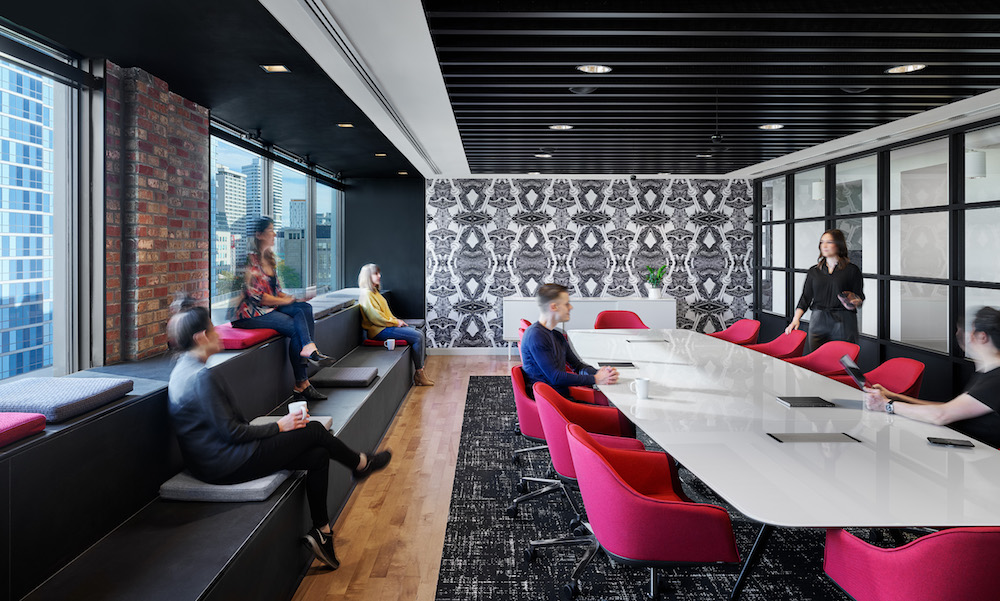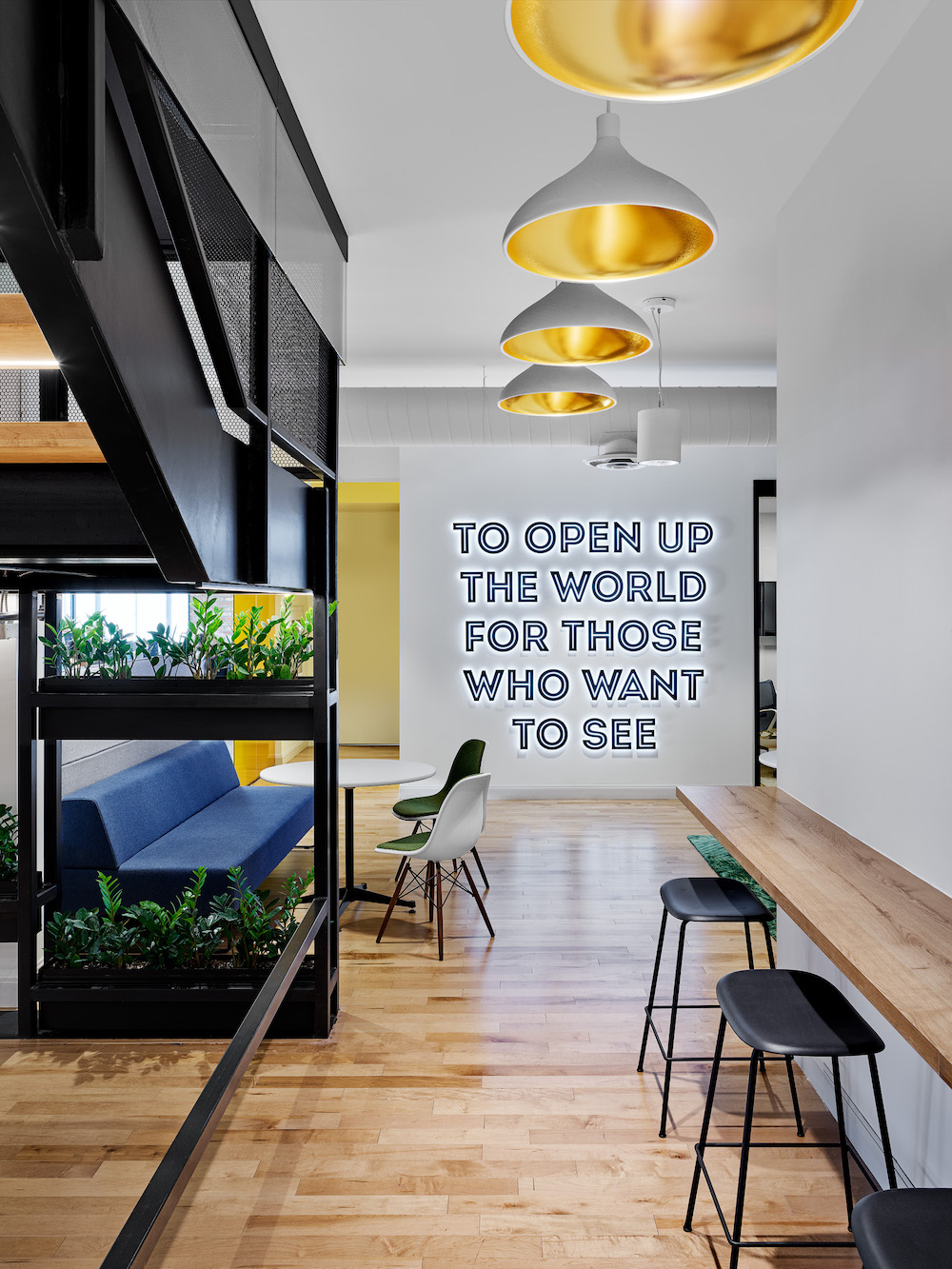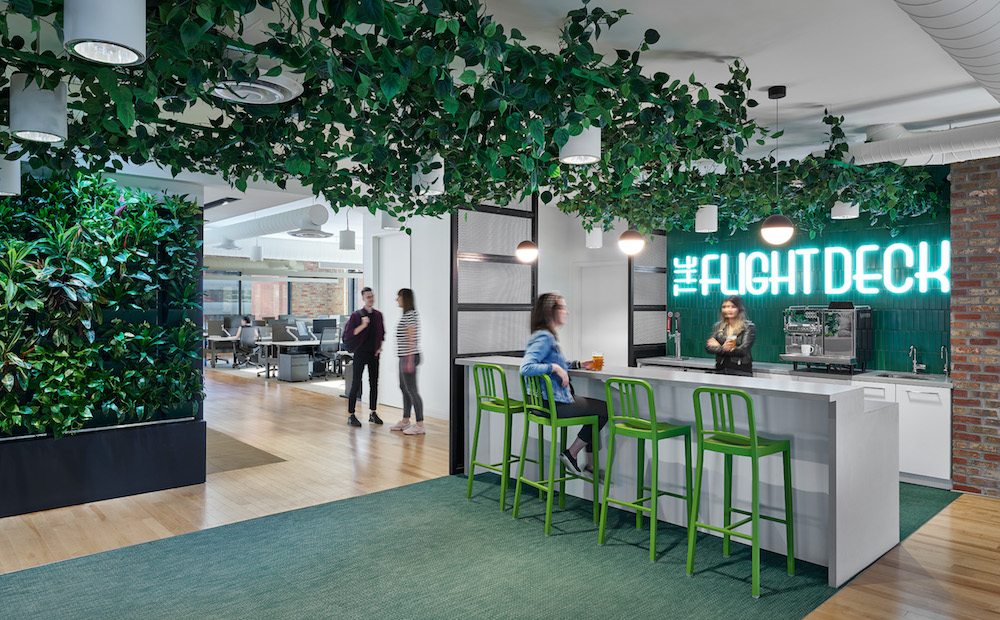Drawing on lessons from successful retail design practices, Figure3’s Mardi Najafi and Jillian Warren make the case for creating more memorable experiences in our offices to improve engagement and brand loyalty.

There are plenty of insights to be gained from examining trends and fresh thinking from other industries. In light of the pandemic, the way many of us work has been reset, and we’ve been made to completely rethink our current offices. Workplace designers can look to inspiration from the retail design sector to support reinventing the office hub for community, learning and culture. Retail designers understand how brick and mortar stores can make genuine connections with consumers and also drive a successful online experience. Our opportunity as we emerge from COVID-19 will be to create a new purpose for the office that is centered around delivering a unique experience – one that will support teams both in person and virtually.

Measuring Performance, The Right Way
An office is not the only place work gets done. Any space that generates value for a business is a workplace, and the nature of that environment shapes the experiences of the people who use it. Rethinking the success measures of the workplace from pure employee densities to one where engagement is at the forefront, will be the challenge of business owners and HR leaders. If we agree that one aim of the office is to build and maintain culture, and connectedness to culture will drive engagement, then a better measure of success may be in gauging strength of culture.
Retailers understand every culture has an unconscious system of signs and symbols that create meaning for that particular group of people. Semiotics (the study of signs, signals and their meaning), provides a conscious mechanism for how to read culture, analyze structure and re-create this meaning. Retailers strive to understand cultural values and make sure their marketing communications and actions reflect the same values of their intended target customer. Semiotic studies of the workplace can guide conscious decisions about the signs conveying meaning to employees. These can be positive or negative, intentional or unintentional. Consider the message conveyed by a bright space with purposeful, comfortable furniture in comparison to that signaled by a crowded, noisy, cookie-cutter space. Designers will be challenged to analyze and translate these cultural values to ensure their actions reflect the same values of their intended target customer, both through the physical workplace and the virtual experience.
Any space that generates value for a business is a workplace, and the nature of that environment shapes the experiences of the people who use it.
An ideal workplace has much in common with the experiential retail environment. Workplace design can use human behavior to choreograph touchpoints connecting employees to culture and the lifestyle associated with the company’s core brand values. The look and feel of a store or workplace should demonstrate this lifestyle. Designing an office space that reflects your company’s values allows employees to convincingly live and support those principles every day. A well-designed space clearly signals to the employees their organization cares about their well-being, which can in turn boost overall morale and productivity.

Offer A Unique Experience
The retail sector has figured out customers not only want to look at goods on a shelf and buy items; they want an experience. Consumers want to associate with brands and shopping experiences that fit into their values and into their lives. Many retailers and brands focus on reflecting their values and culture in their physical space to differentiate themselves from competitors, signaling to their primary target group they share the same values.
Experiential retail is all about connections and delighting shoppers with memorable shopping experiences. In many ways, experiential retailers aim to create communities around their brands. Successful brands and retailers are committed to the creation of authentic, human, and immersive experiences and touchpoints that align with their core brand values and product/service offerings. The new retail store is not focused solely on sales per square foot; that focus has shifted to tracking how many times the consumer wants to come back to the store, and to delivering an experience beyond what they can get through online shopping.
The pandemic has proven what we already expected to be true: the value of the office lies in promoting sharing and learning – both intentional and passive. Millennials are showing lower levels of well-being working remotely; in part suffering from fewer opportunities for informal learning and mentoring to occur, accompanied with social isolation. The office is an ideal space to grow social connections and allow learning to foster. Creating the kinds of community spaces that support connections will result in a reshaping of the places in which people have traditionally worked. By integrating evolving hybrid models of both gathering and individual focus spaces in lieu of what has traditionally been a desk based environment, we can provide an experience uniquely catered to the needs of employees and the business.

First Impressions
How a retailer greets a customer influences them on an emotional level – how they ‘feel’ when they visit the space. In this environment, you will always find the most current product offerings or trends presented in a prominent location. The critical importance of employee engagement is now being realized for the importance it plays in the holistic experience – the most successful retail design layouts focus on staff being available and seen at entrance points, making customers feel immediately welcomed and important. The reason consumers will make an effort to visit a store, is to experience the product and the brand in person. How many times have we stepped into a store and immediately retracted our steps deciding we are not enticed to explore further?
The entry experience in any workplace is equally as important. It is the first opportunity to create a powerful statement immediately connecting both the employee and the visitor with the organizations brand values, and setting the tone for a positive work experience. This goes well beyond a logo mounted behind the reception desk. It is the opportunity to create a powerful first impression conveying the energy and personality of the brand and, clearly identifying what the company does and stands for.
The entry experience in any workplace is equally as important.
Some retail brands have brought the social experience to the forefront. It could be a book store or a cycle club, or a high-energy café or juice bar across the street which draws in a curious passerby. The power of social connection and the ability to meet like-minded people with shared values, has been essential for many successful brands to bring high-energy social experiences closer to the entrance decompression zone and activate those spaces.
So to in our workplaces, creating an arrival area allowing people to experience the company’s purpose and values through curated social spaces and visual cues to the work they do, will build cultural currency.

High-Touch, High Experience
The retail sector clearly knows you can’t just exist online or in the physical world; you need both. A physical presence helps build brand awareness and contact with potential new customers or employees. A digital presence enables convenience. Ideally, the two should be consistently reinforcing the brand from both a design and experience perspective: when a customer engages with either, they should immediately feel welcomed and brand-connected. Retailers now understand creating a positive, happy customer experience lies through understanding what creates happiness: not just delivering what the customer expects, but also in the anticipation of that delivery and the memory of it. Unpredictable and surprising moments are more likely to be remembered than expected moments. Therefore, successful retail design now focuses on creating memorable experiences that entice the customer to return, or even tell their friends about their brand.
Businesses can also apply this same thinking to their workplace technology upgrades. Finding and connecting coworkers in the virtual domain should be as easy as visiting the person’s desk. With the increased use of online technology platforms, the future of evaluations and changes will become more data-driven, with decisions based upon an array of actual qualitative metrics. Similar to retail, it can be expected that organizations will eventually create customized platforms unique to their own business operations to collect data and evaluate employees’ digital experiences and productivity.

Technology, if used and introduced correctly, can be a great platform to spark a theatrical experience in the physical workplace. Using digital monitors to show brand messages, past projects or company history can also be great ways to enable employees to connect with their workplace. Tools such as video conferencing, interactive whiteboards, voice integration and facial recognition devices, are a few tech examples that create visually impressive scenes while also generating a seamless experience for employees themselves.
Mobile sensor technologies such as geolocation, Al, and in-store beacons are now being leveraged by retailers to give consumers a more personalized and immersive experience each time they shop. Occupancy sensors including heat mapping and AI analysis are becoming more common in workplace design as well, with data able to inform layout changes and more intuitive travel paths. Choices can be made by employees in real-time whether it be to choose which coffee station to visit, or which meeting space to book.

Mapping The Experience
When creating a store theme layout, many retailers start by mapping how the intended customer journey will unfold in the space – how will customers navigate the space, and what will they see first? To draw from this strategy, in workplace design we must consider the path each employee takes as they walk to their desk or office. What can we put in their path to reinforce the corporate vision and purpose?
Journey mapping is a tool used by researchers to understand user behavior by plotting out actions, identifying successes, and where improvements can be made. Designers can apply this methodology to plot and study desired experiences and emotions. Identifying the opportunities for spotlighted experiences can help dictate where brand messaging would be most impactful referred to in retail design as “rewards and happy moments”. The content and visual merchandising of such designated sightlines must always evolve and change based on a marketing calendar. Failure to continually renew their messaging puts retailers at risk of obsolescence or a designation to “visual clutter”.
A sensory-driven experience can be a successful layer to represent an organization’s brand and culture.
What is an example of a reward or happy moment in the workplace? Alluring and engaging spaces such as cappuccino bars, wellness spaces, lounges, and workspaces that promote diverse activities and employee comfort are a few examples. Having a variety of options of places to land and activities in which to interface, go a long way to keeping employees engaged as they move about the office. In the same way stores create multiple displays for a variety of products; these in-office choices create areas of freedom and opportunities for creativity for employees.
A sensory-driven experience can be a successful layer to represent an organization’s brand and culture. Biophilic design and a curated use of texture and color distinguish “hot”, more active spaces from “cool” quieter zones. Inspirational quotes, employee recognition or staff doodle walls, can be a powerful way to instill pride in employees; by emphasizing the important role they play in a greater whole and supporting a meaningful connection to each other, and to the purpose of the organization.

The Real Deal
In retail design, authenticity reigns, and nothing can replace knowing and experiencing a brand. If the space or the customer experience is underwhelming, your consumer will feel it. Good brand design is tailored to customer engagement at every touch point and the design decisions reinforce the brand, answering questions such as: What is the unique offering? What is the unique culture? What makes me want to come into this store rather than the one across the way? What is their point of differentiation?
And finally, today consumers expect a relationship with the brands they frequent. This means that they want a brand to “know them”, and offer them a personalized experience. They want immediacy, with real-time offers and instant communication. They want to share good experiences on social media and feel empowered because they have numerous brand choices.
This halo effect now also plays a much bigger role in the workplace, which greatly impacts the way we design the places in which people work. An engaging environment, a thriving culture, a sense of belonging, and a purpose to be proud of is critical in drawing people to place, and making that place one in which people are choose to spend their quality time. Clear knowledge of the primary users of the space must drive the design to accomplish this. It isn’t only about reflecting identity or personality, but also reinforcing what it’s all about – continually building loyalty and impressing staff and visitors alike with the company’s dedication to its brand promise.

